Posts Tagged ‘tough on crime’
Posted on: April 3rd, 2014 by Smart on Crime
Alison Neighbourhood Community Centre is neighbourhood-based organization that works with volunteers to support residents who live in the Alison Neighbourhood in East Galt, Cambridge. We support residents, families, children & youth by offering after school programs, youth drop-in programs, community events, family outreach services, and volunteer opportunities.
As a member of the Waterloo Region Crime Prevention Council and as community partners of a couple of the InReach project host sites, we were able to hear about some of the wonderful opportunities to which the youth were exposed as a result of InReach that they would not have experienced otherwise.
How InReach Resonated with the Work We Do
- We too, focus on building on strengths and capacities of young people
We have worked with youth who have great dreams and aspirations for the future, but have trouble putting their vision into a workable plan. On the other side of the coin, we have worked with youth who have little to no confidence in their abilities, thus requiring a little more encouragement and a little more trial and error in determining what really gets them motivated and excited.
In our experiences, many youth have difficulty simply picking up a new hobby as a means to divert themselves from more harmful and negative activities. Let’s say a young person decides to try something new: Inspired by an Instagram pic of a friend of a friend’s cousin rock climbing out West, Andrew decides he wants to give it a try. A few initial barriers come to mind: Other than that distant personal connection, he doesn’t know anyone else who rock climbs, he doesn’t know where he would go to rock climb, and has no idea what is needed to get started. How much is it to join? Do you need a membership? What type of equipment is needed? Does that cost more money? The idea is now overwhelming. For a youth who has not had many life experiences nor opportunities, it is likely that these questions wouldn’t even be on their radar. It is much easier to continue along their existing path, wherever it may lead.
In our experience, the recipe for youth engagement is as follows:
- Exposure to a new activity must take place in an accessible space where youth feel safe, where they won’t feel like they are being judged and feel comfortable to try, fail, and then try again
- In order for this to happen, relationships must be built with program staff. And in order for this to happen, staff must be skilled in outreach and community development practices so that they can effectively meet the youth where they are at before they will even walk through your door
- Youth need to be involved in the planning process and have input and control over what happens next
- It takes time, commitment to seeing the initiative through, trial and error, one-to-one support, and constant encouragement to ensure that youth are getting the most out of the program.
Bottom Line: You cannot expect certain youth to simply sign up for an activity, attend regularly, and thrive without support, a trusting relationship and input into the program’s design and execution.
- We have learned to adapt to the growing complexity of the needs and issues of youth
We offer programming for youth under the guise of recreation. When I first started working in the field, I had a very pretty picture in my mind about what the harmonious world of recreation should look like: Mom or Dad would drop off their kid for our program, (on time), sign-in would be completed in an orderly and organized fashion, and we would all participate in an rousing round of basketball. At programs end, the youth would depart safely for the evening and everyone would be so happy. I hope you can smell the sarcasm here, because this picture couldn’t be any further from our reality. On paper, we offer programs such as Teen Night, Basketball, Girls Night, etc. In reality, we offer mentorship, leadership development opportunities, a place to belong and be heard, support and guidance, a respite from family and relationship trauma, something to eat, relief from the stresses of coping with depression and anxiety, an escape from the pain and constant disappointment of poverty, an opportunity to practice speaking English, access to individualized supports such as counselling, emergency food sources, career resources, addictions supports, relationship and grief therapies, and the list goes on and on. Ultimately, by the time we have a chance to check in and talk to everyone who was fortunate enough to even arrive to the program, there often isn’t time to play basketball.
- We need help keeping programs like these going so that we can reach more youth
Just because the InReach project is now “complete” doesn’t mean that there still isn’t more work to do. With as many partners, staff, support agencies and youth impacted by InReach, I hope that the trajectory of this valuable project will not be lost and its lessons forgotten. The truth is, there are thousands of youth living in the Waterloo Region that could really benefit from a community treatment team; a one-stop-shop where youth can access support to face a combination of issues (see above) unique to only them, right in their own neighbourhoods. Effectively addressing these issues takes partnerships, patience, commitment, resources- all things that that the InReach project so successfully exemplified.

Author: Courtney Didier is the Executive Director of Alison Neighbourhood Community Centre in Cambridge. She is very passionate about creating sense of community and inclusion, not only in her neighbourhood, but across the Waterloo Region. Courtney is expecting her first child any day now!
Posted on: April 2nd, 2014 by Smart on Crime
Being an avid hockey fan, I await the joys of the upcoming Stanley Cup playoff run. But with this expect many interviews, with standardized questions with the same responses from each player. The questions never change based on a given answer, and the answers never change from game to game, and year to year for that matter. They are all cliché based interviews. How is this relevant to inREACH?
Having been with inREACH, it became quite evident, that the youth we worked with often experienced clichés in their lives. They were labelled, stereotyped, and their behaviours were often predicted by the adult world around them, yet most of the time no one knew anything about them. Outside of where they lived, or who they hung out with, or the school they went to, or perhaps what they look like, do many even know these youth? The label which is the umbrella they live under is their cliché.
While working with inREACH, the approach we used broke down these barriers, the labels, the assumptions. That is what worked. Did we listen to them? No; we heard them. We can use our own clichés about giving hope, opportunity, a chance, but it only works if we know what to give. That was done by hearing their story. Their story does not have to be a given. It is not just about where they have come from, and what they are going through, it is also about where they want to go. If we hear them, we can help them. inREACH worked because no assumptions were made. Each youth had their own “Stanley Cup” they wanted to lift, but the battle to get there was the unknown. After each session or meeting with a youth, there were no cliché answers or questions. There was the concept of acknowledgement of ability, an identification of assets, and no reason to suggest why that youth could not raise that cup, whatever that cup was from him or her.
There was a time where we were asked to do a presentation on working with high risk youth on behalf of a community agency, and the reason for such information was the staff was stressed due to not feeling successful in working with this population. Initial feedback as to why the training was needed was the youth do not listen; they are always angry, disrespectful etc. Perhaps part of the issue is as adults, we make assumptions of where these youth have come from. This was a huge learning curve I believe many of us have yet to master.
Recently I watched the film “Short Term 12”, about youth in a group home, and a new staff member in the film was asked to say a few words to introduce himself to the group. His response was: “I always wanted to work with under privileged youth”. That comment didn’t go over very well. My first reaction was shock really, as the moment the categorization of ‘under privileged’ was used, any potential trust is already gone (as the youth were not too happy). The scene reminds me so much of what inREACH was about. Youth are…really….just youth. No adjective required. And really, I do think that is what is being missed. That point was driven home while with inREACH.
Often, we as adults rely on labels, as they are easy to work with clichés that fit into a nice little box for the ease of comfort.
In my continued work, I think it is of the upmost importance to truly find out what the youth needs, or wants, and feels. To reflect on what the youths’ words are, shows they have been respected, and valued, and heard. That is the start of their quest for their Stanley Cup.
Moving forward, what is my message? I won’t give any clichés here that you will assume I should be making now. What I will say, is do you know the path I took as a youth to get to where I am right now (working in social services for 14 years)? I will bet most likely not. I was a youth. We all were. That is the cliché I will end off on!
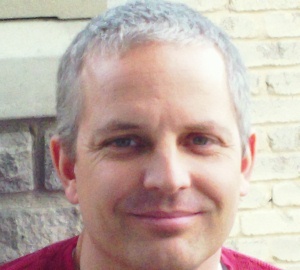 Author: Karl Garner I was a Case Manager at inREACH a focus on employment for the youth. I am currently working at John Howard Society with the Youth in Transition Program, a program for Crown Wards. And want to know a fun fact…? I still play my major passion every week…HOCKEY!
Author: Karl Garner I was a Case Manager at inREACH a focus on employment for the youth. I am currently working at John Howard Society with the Youth in Transition Program, a program for Crown Wards. And want to know a fun fact…? I still play my major passion every week…HOCKEY!
Posted on: April 1st, 2014 by Smart on Crime
I spent a couple years working as a Youth Outreach Worker with inREACH. I spent most of my time in the Preston Heights neighborhood and also in the Paulander community. I was part of the Community Mobilization phase of this pilot project and assisted the youth in running events/programs.(ie.. Art Studio, weekly youth drop-in, sports evenings, homework help group,..) Our approach with youth was very relational and strength-based. inREACH provided an environment that definitely steered us away from the traditional way of working with youth.
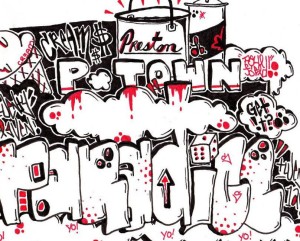 A big part of these two years was assisting the youth in opening a Youth Art Studio. This studio gave opportunities for at-risk youth to express themselves through the creative arts. It gave the youth a chance to engage in a new and healthy outlet to express their emotions, as well as cope with current and past adversities. I also assisted these youth in running their very first Art Show at a local gallery. Some sold their art, some made the paper; but more importantly I noticed a huge boost of confidence in each of the youth who took part in this.
A big part of these two years was assisting the youth in opening a Youth Art Studio. This studio gave opportunities for at-risk youth to express themselves through the creative arts. It gave the youth a chance to engage in a new and healthy outlet to express their emotions, as well as cope with current and past adversities. I also assisted these youth in running their very first Art Show at a local gallery. Some sold their art, some made the paper; but more importantly I noticed a huge boost of confidence in each of the youth who took part in this.
Over the years I always found the act of creating art a very therapeutic experience for the youth I worked with.
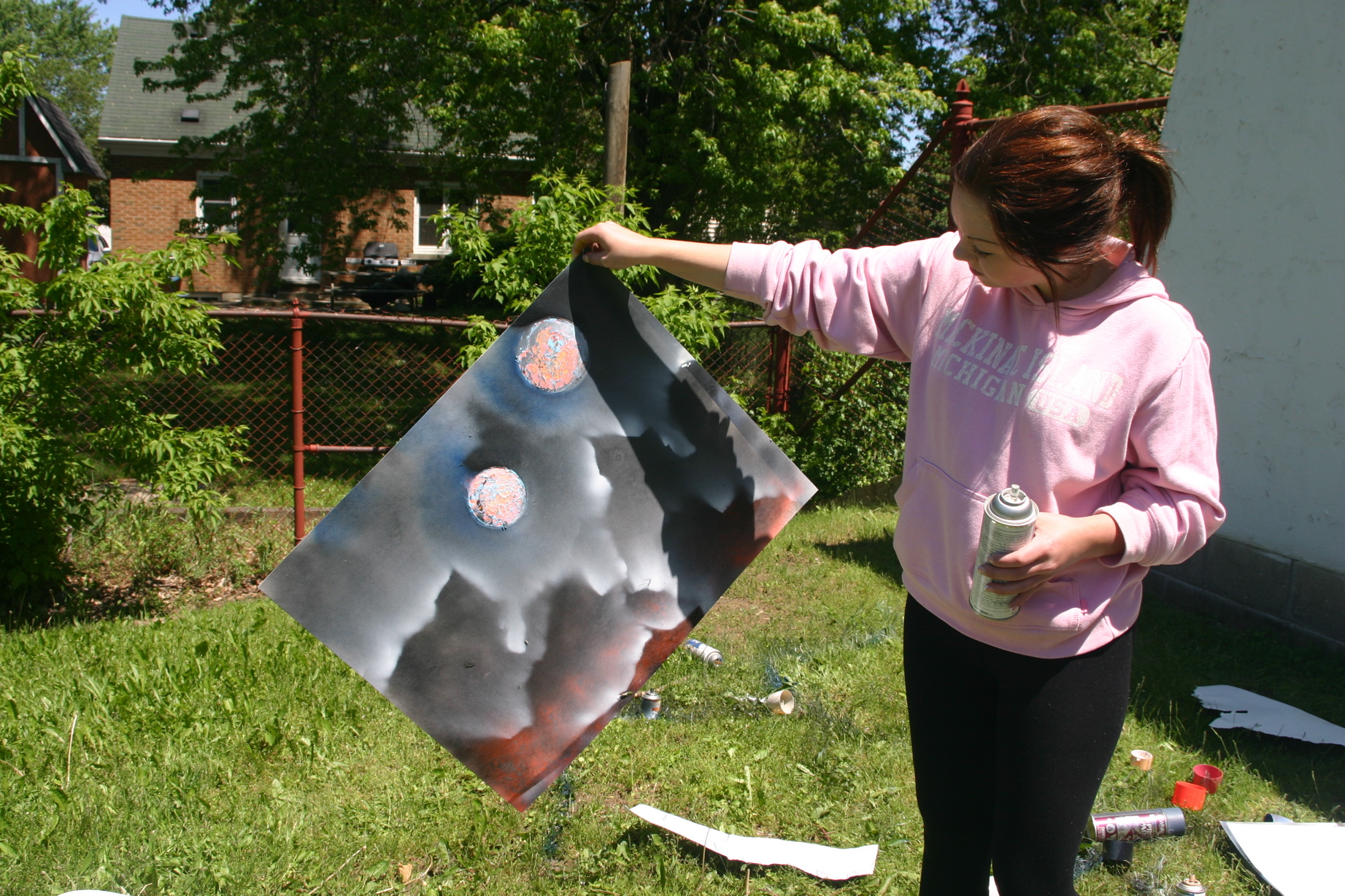
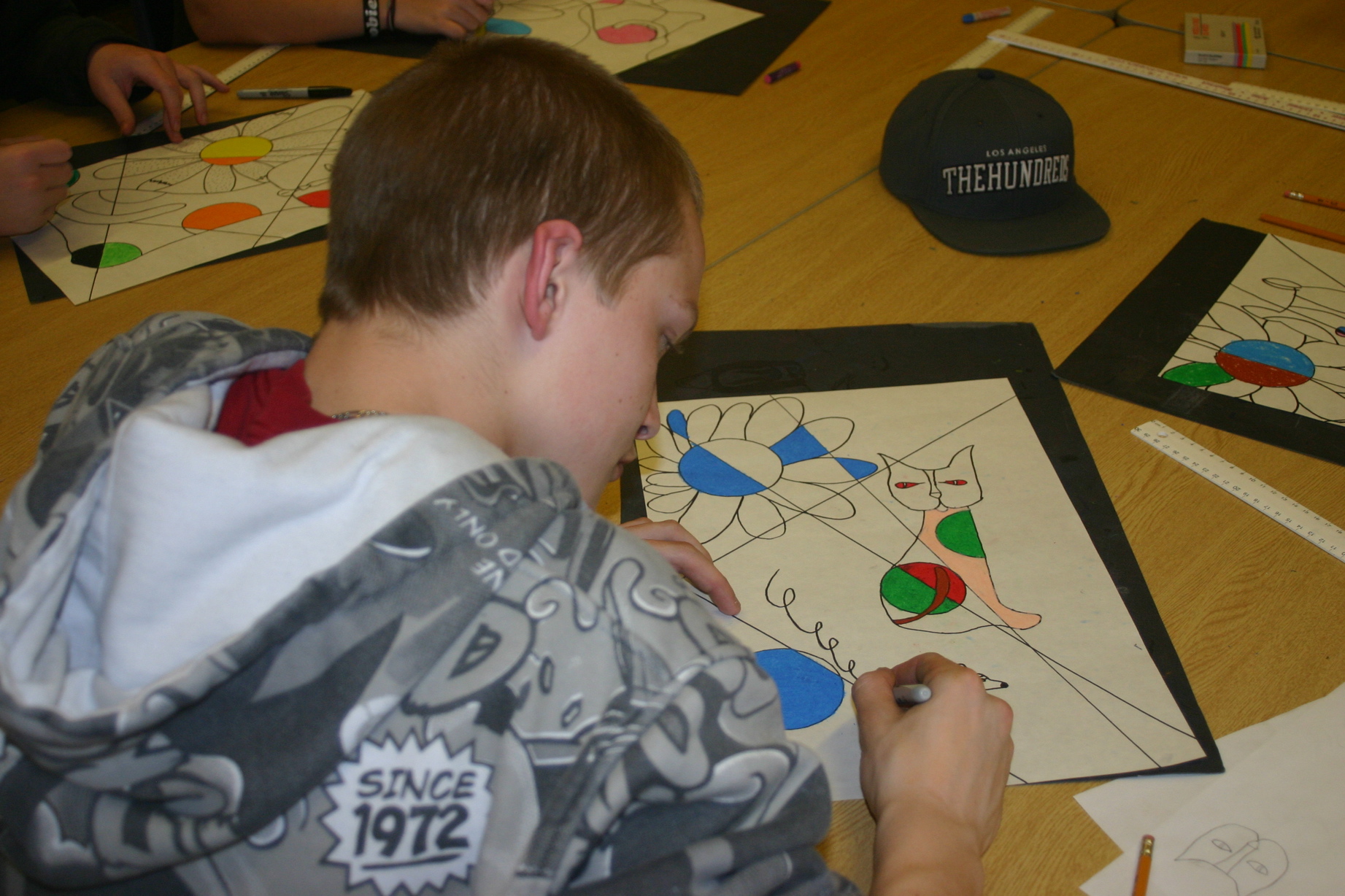
With inREACH closing due to lack of sustainable funding, I decided to start a for-profit business that would fund an Art’s program for at-risk youth. I started Art Innovators Waterloo Region. I hired a team of Art Instructors in the beginning of 2013, and we now provide after school/lunch time Art Programs in over 30 schools within 7 local School Boards. These programs are all parent paid. We also now run Art Camps, Corporate Team building Art Classes and Seniors Art programs. I use the profits from these programs to fund art programs for at-risk and disadvantaged youth.
I run programs in local alternative schools and youth shelters like Argus (males), Argus (females), Monica Ainslie Place, New Dawn, New Way, etc. I am even able to continue to connect with some of the youth I had worked with through the inREACH project. I am very excited to be running an art program with Community Justice Initiatives in a local Custody facility (GVI). I am also able to offer free scholarships to many families who cannot afford our Art Program in each of the schools we partner with. One of my free art programs starts next week in a Waterloo Region Catholic school in the Paulander Neighborhood.

I feel that my experience with inREACH had an important part to play in starting Art Innovators here in the Waterloo Region.
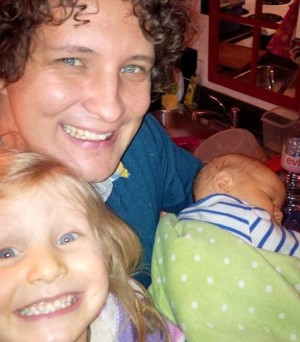 Author: Paul Field
Author: Paul Field
I am the middle child of 7 brothers and grew up in the country. I spent the last dozen years working in the Social Work Field in settings such as Schools, Group Homes, Rehabs and Youth Drop-in Centers. My passions have always been working with youth, travelling and creating Art. I am blessed with my beautiful wife Liana and two amazing children; Willow and Lachlan!
Posted on: March 31st, 2014 by Smart on Crime
My experience with the inREACH project began when the Community Mobilization team was formed. I was one of 4 Youth Outreach Workers, working primarily in the Courtland Shelley community as well as in the Paulander neighborhood, both in Kitchener. Our job as Youth Outreach Workers was to work within the neighbourhood to help make young people feel a greater sense of belonging and security within their community.
inREACH fostered a working environment that not only allowed us, but encouraged us to work outside of the box. I’d be lying to say the task was not daunting at first. In my previous experience working as a Youth Worker I had never been given such flexibility and confidence within a position to achieve the desired outcome; an outcome that was not based on the amount of programs ran or number of program participants but the ability to engage youth in their community. We were not given a method to do this; it was easy to see that each of the communities we worked in were uniquely their own. We were introduced to the Spergel Model to use as a foundation and approached our communities in a very strength based, relational approach.
What I appreciated most about working with inREACH, and what I have made a conscious effort to take with me in my work is the time we were given to establish relationships. I spent the first couple months getting to know and understand the community I was working in. I was given the flexibility to do this in many different ways. I spent time outside playing with the kids, going to adult classes or food distributions at the community centre, attending parent council meetings, sharing food with youth, and just hanging out in parks, the malls and parking lots. Any place I thought I might connect to the community I went. inREACH and my working agency, House of Friendship gave me the time to make my visual presence in the community known, and to establish trust and rapport with the youth and their families. Although there were days this time spent within the community did not seem valuable, it was undoubtedly critical to the success of working with the youth in these communities – taking the time to establish a solid relationship allowed for programs, education and training to be successful later in the project.
Through my experience at inREACH I also saw success in an alternative approach to programming. Many community agencies believe that after a certain age youth are not interested in being involved in their community or attending programming at a community centre. I myself have even been guilty of some of those thoughts, however after running strong programs I realize now that it is all in the approach. Creating successful, well attended programs began with the relationship that was formed between the youth and me in the first couple months of working in the community. Through this relationship I was able to discuss with the youth what types of programs they would like. Focusing on their strengths and interest, the youth were involved in the planning and implementation of the programming, right down to the days and times they thought would work best. This created a program that they had interest and ownership in. I also learned to allow the programs to change and be flexible. Programs that initially were successful became less attended and needed to change according to the youth and their needs. Our funding from inREACH allowed us to do many impactful things with the youth outside of their community. Although these things were very important I saw how programming within their community helped the youth to feel a sense of belonging and safety within their neighborhood.
I am pleased to say that the Courtland Shelley Community Centre continues to run youth programs established through inREACH. I have been fortunate enough to remain working at these programs and to sustain relationships with many of the youth I worked with through the project. House of Friendship allows me to continue using approaches that help to enhance my relationship with the youth and run programs that represent their changing needs and wants.
My experience with inREACH has been invaluable. Working with the project has strengthened my skills and competency as a youth worker. I am proud to have been a part of such a unique project that united so many community agencies in collaboration. The inREACH project may have ended, but I take with me inspiration from the youth as well as for the future of youth engagement in the Waterloo Region.
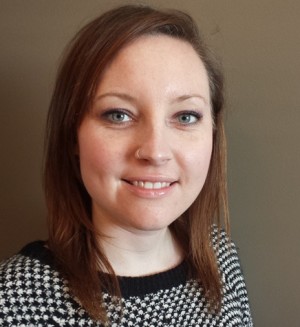 Author: Krista McCann
Author: Krista McCann
With an education in Child and Youth Counselling Krista McCann has spent several years working with marginalized children, youth and their families. Krista is dedicated to creating relationships and environments for youth to thrive.
Posted on: March 27th, 2014 by Waterloo Region Crime Prevention Council
I agree with the sayings – ‘there’s always more to learn’ and ‘it’s never too late to learn.’
I lived this out when I returned to university for a Masters degree the same year my daughter started university. Luckily she wasn’t too embarrassed to be at school with her mom. My timing turned out to be perfect for another reason as well. During my time in school I had the amazing opportunity to be involved with the research and evaluation of the innovative and highly successful gang prevention project, inREACH. I can guarantee you; I learned something new every day.
An excellent summary of the evaluation report for inREACH highlights a LOT of really important learning and accomplishments as a result of this collective community effort over the past few years. Sharing our story: Lessons learned from the inREACH experience describes how the project was implemented, the young people it served in the treatment and prevention programs, and the many positive impacts of the project on young people, neighbourhoods, organizations and the community as a whole.
 The most important lessons and understandings learned from inREACH will inspire community action toward a future where all young people feel part of a caring community and have the opportunities and the supports they need and deserve. But, any evaluation isn’t even worth the paper it’s printed on if it just sits on a shelf. We need to apply the evaluation findings so that we can affirm what might already work but also make changes where needed.
The most important lessons and understandings learned from inREACH will inspire community action toward a future where all young people feel part of a caring community and have the opportunities and the supports they need and deserve. But, any evaluation isn’t even worth the paper it’s printed on if it just sits on a shelf. We need to apply the evaluation findings so that we can affirm what might already work but also make changes where needed.
Here are 3 key things we learned from the inREACH experience that could help us more effectively engage young people who are marginalized and better address their needs.
It Works!
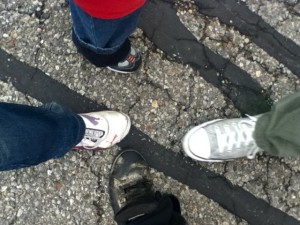 Some believe that teenagers – particularly those labelled as “trouble” – don’t want to be involved in community activities or mentoring relationships with adults. The evaluation busts that myth by demonstrating very clearly – that if organizations and communities take the right approach – then many adolescents and young adults, will participate in asset building activities like arts and sports. Many will also seek assistance for challenges they face with things like addictions, gang involvement or finding a job or a home, when they have developed a trusting relationship with an adult who meets them ‘where they’re at.’ The evaluation results also clearly demonstrated that when young people got involved in their communities and received help with life challenges, they experienced many positive benefits and changes. Over 95 % of youth agreed their involvement “helped them move in the direction in life they wanted to go.” For example, youth said:
Some believe that teenagers – particularly those labelled as “trouble” – don’t want to be involved in community activities or mentoring relationships with adults. The evaluation busts that myth by demonstrating very clearly – that if organizations and communities take the right approach – then many adolescents and young adults, will participate in asset building activities like arts and sports. Many will also seek assistance for challenges they face with things like addictions, gang involvement or finding a job or a home, when they have developed a trusting relationship with an adult who meets them ‘where they’re at.’ The evaluation results also clearly demonstrated that when young people got involved in their communities and received help with life challenges, they experienced many positive benefits and changes. Over 95 % of youth agreed their involvement “helped them move in the direction in life they wanted to go.” For example, youth said:
“they taught me to actually think before I acted…just keeping my cool overall and staying relaxed and not being so stressed out.”
“It helped me see the value of myself.”
Learning what it takes – with youth
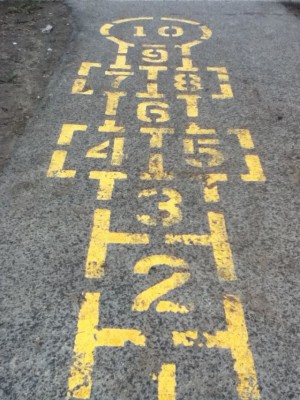 Sharing our Story describes key elements of the inREACH approach that was so successful. It took
Sharing our Story describes key elements of the inREACH approach that was so successful. It took
- the development of trusting relationships between staff and young people;
- listening to the youth and involving them in decision-making,
- recognizing youths’ strengths, skills, and interests, and
- making programs and services more accessible.
The evaluation report fleshes out some details of HOW to implement these approaches, which is the challenging part.
One illustration follows:
“I don’t think that they have ever had an adult say “what are your dreams?” and “how are you going to achieve those?” and then try to help them… That is my biggest question when I first meet a kid….it gets them thinking…. Then believing in them too and showing them you really care.” (Project staff)
Learning what it takes – the community’s role
inREACH was a collaborative venture of multiple organizations. The evaluation documents how these partnerships enabled organizations to work together more effectively, to work with youth in a different way, to access more services and resources and to “produce systemic change – changes in the way systems and organizations in the community approached the problem of gangs and at-risk youth.” (p 10)
Feedback to Community
It was important to report back to people who shared their thoughts and stories of involvement so I returned to many of the neighbourhood programs. Young people were keen to take the summary booklets and some were excited to see their own photographs featured there. Some youth who had been interviewed wanted the full 140 page version, partly to see if they were quoted there. There was a sense of pride for what they had created and accomplished and some commented on the huge difference the programs made in their lives.
 Continuing the Learning
Continuing the Learning
We know that if fewer adolescents and young adults experienced marginalization due to where they live or the challenges they face, then fewer young people would be attracted to gangs as a solution to their problems or to find a sense of belonging. So, it begs the question…. What should the community take forward from this youth gang prevention project?
There’s so much to talk about – outreach, social media, a youth engagement approach, new ways of collaborating across agencies, the role of neighbourhood community centres….
We look forward to working with our community to keep learning, but also move the learning to action. The upcoming event “Engaging marginalized youth” will help us do just that and you can join us on Friday April 11, 2014. Registration is required for the event and you can register here. [UPDATE: this event is now SOLD OUT. You can still register but you will be added to the wait list in case of cancelations.]
There’s always more to learn…
Photo Credits: all photos taken by inREACH youth during PhotoVoice projects. 2012
Posted on: March 25th, 2014 by Waterloo Region Crime Prevention Council
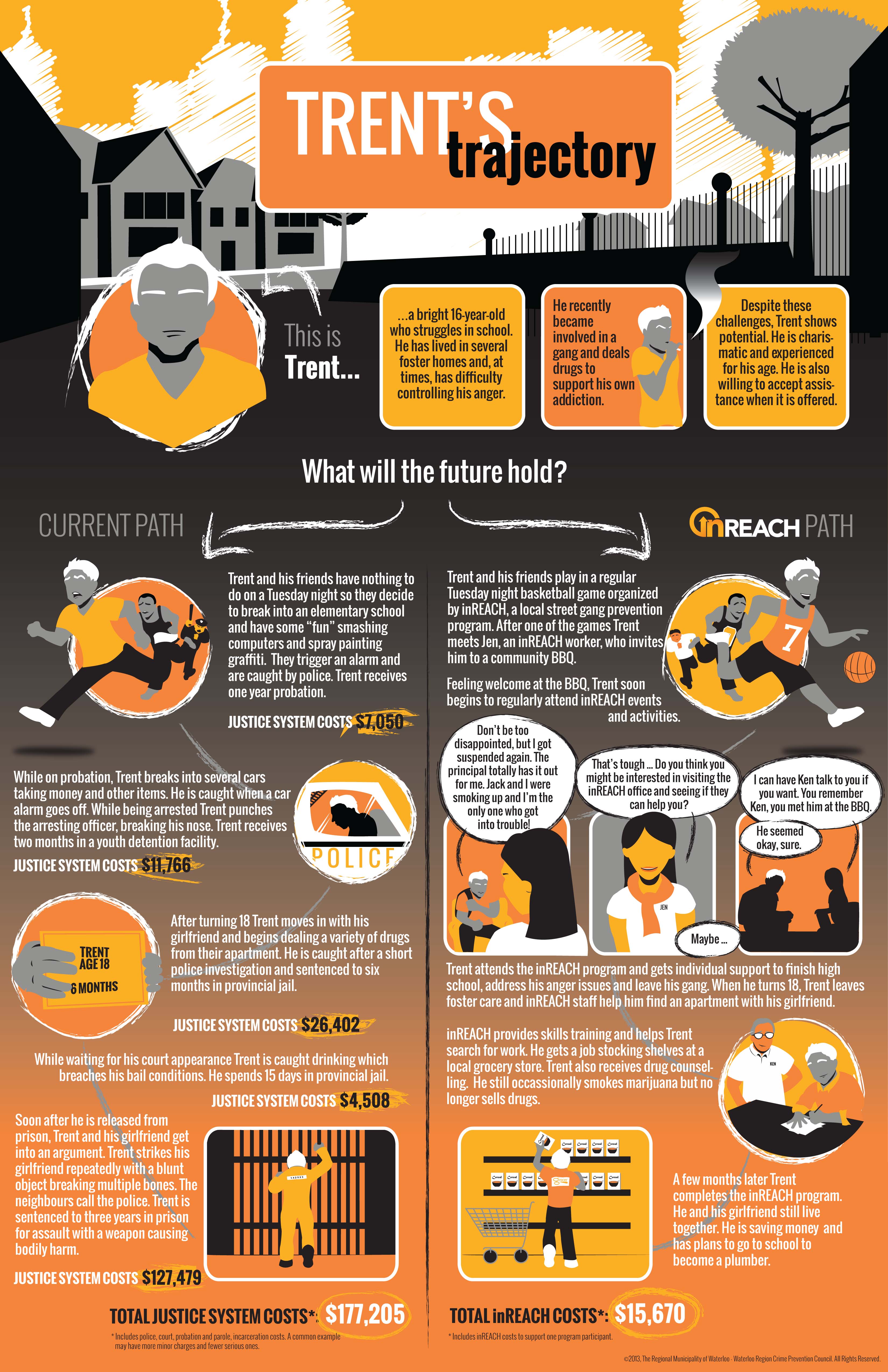
Trent’s Trajectory is fictional account of a sixteen year old teenager as he becomes an adult. The infographic, created by Wade Thompson, begins by discussing the risk and resiliency factors Trent faces. The story then branches into two paths. In the first path, Trent does not receive community supports and his risk factors drive the story culminating in a three year prison sentence. In the second path, Trent receives supports from the inREACH project. His resilience factors grow and Trent successfully transitions into adulthood.
Typical stories from the justice system and the inREACH program build Trent’s fictional story. Due to space constraints the ‘current path’ contains less minor crimes than would be expected from a repeat young offender and a few more serious ones. While this slightly changes the story, the overall justice system costs are realistic. It is important to note, while the story is specifically about the inREACH program similar outcomes can be reached for at risk youth in many other prevention programs.
Does this raise any questions for you? What do we do with this information now that inREACH has ended?
Posted on: March 10th, 2014 by Smart on Crime
When United States Attorney General Eric Holder made gave his “Smart on Crime” remarks to the American Bar Association’s Annual Convention in San Francisco on August 12, 2013, it “launched a comprehensive review of the criminal justice system in order to identify reforms that would ensure federal laws are enforced more fairly and—in an era of reduced budgets—more efficiently”.
If you’ve been following the ‘smart on crime’ news from the United States since then, it appears they are leaving few stones unturned. In the case of mandatory minimum sentencing for drug offenses, there seems to be a lot of evidenced-based research to support their justice reform directions.
As an example, take a look at these Federal Bureau of Prisons infographic charts in a recent Huffington Post article on the impact of prison overcrowding:
U.S. Prison Population As Of Jan. 25, 2014
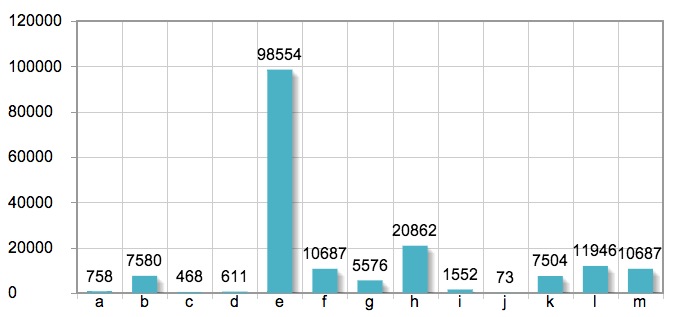
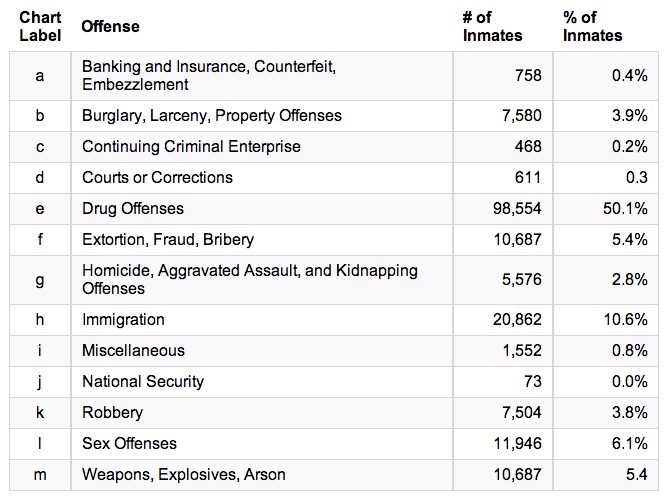
Data is limited due to the availability of offense-specific information.
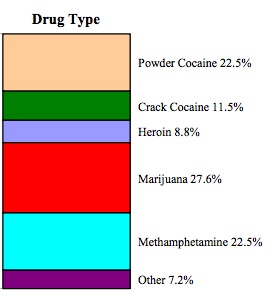
See the full article here.
Posted on: December 17th, 2013 by Waterloo Region Crime Prevention Council
The crime rate records the amount of police reported crime per 100,000 people. In this number, all crimes are counted equally. This represents approximately one third of the crime that occurs in Canada; this varies by jurisdiction and type of crime. The Crime Severity Index and the Violent Crime Severity Index weight crimes according to their severity based upon average sentencing outcomes. Crime and violence severity indices address the crime rate being driven by high-volume offences that are of a less serious nature.
The Statistics
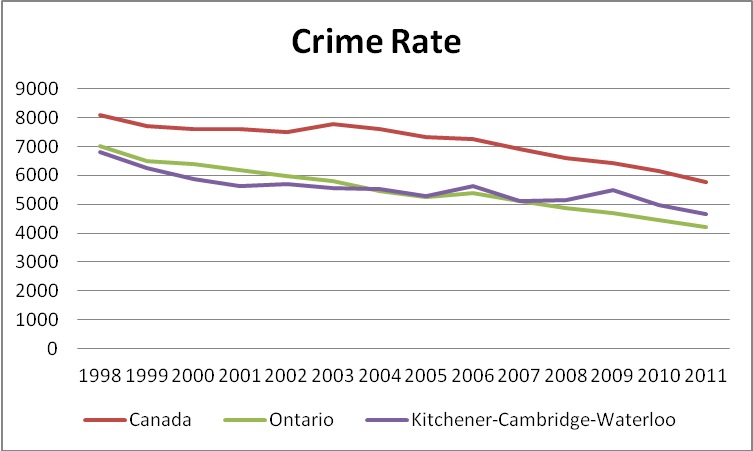
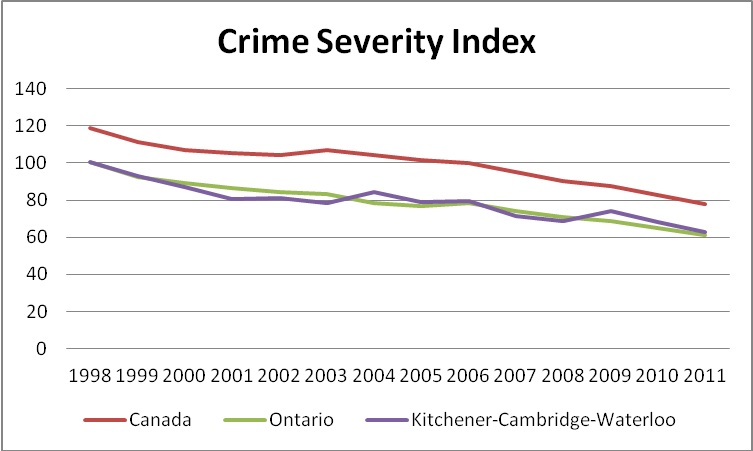
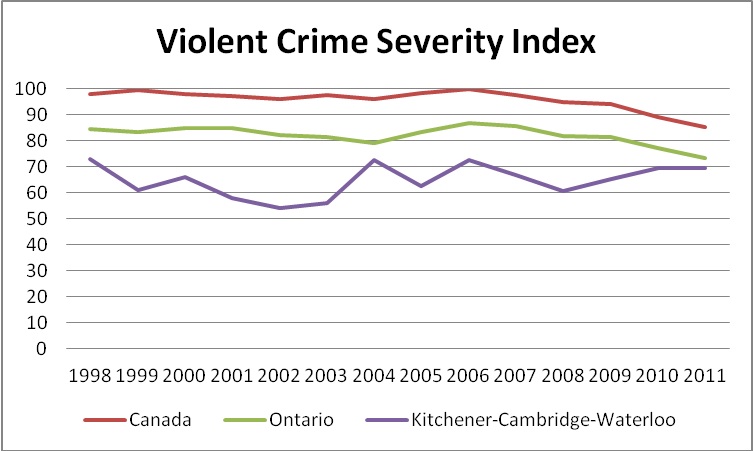 Date Sources: Statistics Canada, Uniform Crime Reporting Survey: CANSIM Table 2520051
Date Sources: Statistics Canada, Uniform Crime Reporting Survey: CANSIM Table 2520051
Statistics Canada, Uniform Crime Reporting Survey: CANSIM Table 2520052 (Released Annually)
The Story Behind the Numbers
Posted on: March 21st, 2013 by Smart on Crime
My recent trip to Canada held one major surprise and the image, vivid after more than two weeks, of a kid in a red shirt.
I returned from a meeting-packed three days in Winnipeg, where I keynoted two conferences (one at Winnipeg University’s “Thinkers’ Conference”), participated in panels, shared thoughts with people working with at risk kids, and engaged in discussions with political and policy leaders. I also had the pleasure of spending a good bit of time with the Conference’s closing keynoter, Shulamith Koenig, an absolutely amazing woman, the recipient of the 2003 UN Prize for Human Rights.
When I’m on a speaking trip, I always want a jammed schedule: I refuse to air-drop in, give a speech and leave. I’m eager, no, more, I need to steep myself in what’s going on locally: I always learn, returning home spurred on by new ideas, new approaches.
I asked Bob Axworthy, the tireless conference coordinator and my “minder” for the three days, to give me in addition to everything else he had scheduled, the opportunity to speak with a few young people. “I’ll take you to Saint John’s in the city’s North Side,” he said. “Good bit of crime. Low graduation rates. Located in the highest crime area of the city.”
I had difficulty pulling myself away from a conversation at “New Directions“, and so arrived late at North High. The principal quickly took me upstairs, where I met a somewhat guilty-looking Axworthy. “Here’s a microphone. You’re on!” “I’m on?” He held open the door, which led to a stage in front of which sat “a few kids” – about 350 of them at a school assembly.
After whispering to Axworthy that I was going to get even with him, I began with a personal note, describing the profound influence Dr. Martin Luther King had on me and my career. Not much resonance. So I shifted to them.
I had no notes, but this is what I recall of the hour with the kids. “I’m glad you’re here,” I began. “Many of your friends aren’t. Many, if not most of you, have been through a lot of stuff. Some of you have mothers on crack. Some of you may have a dad in jail. Some of you may have seen friends or relatives hurt badly, maybe even killed. Some of you have been on drugs. And some of you have been abused physically or even sexually.
“But guess what? You’re here. You’re in school. And for some of you, that takes about every ounce of strength you’ve got. What’s even more important is this: what you’ve been through, the tough stuff, gives you a skill. You’ve got a friend who’s into drugs? If you’ve been there, you can help. If you’ve been hurt or lost a dad you can help another who’s going through the same thing. You’ve got pain. We all have some. You have more than most. It’s not going to go away fast, so use it to help others. You see, your pain must not be wasted. And helping another go through the hard stuff will ease your pain like nothing else.
Then I shifted. “Let’s look at what it takes to make it. We’re going to share thoughts about resiliency. A big word. Who knows what it means?” Most hands were in total lock down until one kid ventured, “Hope.” “Close. We’re getting somewhere.” Then this, from a half-slouching, half-grinning kid in a red tee shirt: “It means making it when you’re not supposed to.” “Brilliant,” or something like it, I replied.
The Search Institute, the nation’s premier strength-based/resiliency research entity, points to 42 resiliency characteristics. I have my top five, and began to share them with the kids. I tried hard to involve as many of them as possible, but got only six or seven hands, maybe more. But one thing was clear: Red Shirt dominated, legitimate domination, for without wanting to show it, he watched me like a hawk, and was right on top of most questions…and the answers.
“Number one, a goal,” I began. “You are bound and determined to complete something. It can be small, like making the soccer team, passing your English class. Or it can be larger: graduating, getting a job, being the first in your family to go to college. The point is this: you are determined to make your goal. You are focused. You’re going to get there. Nothing’s going to stop you. If you don’t have a goal, anything can knock you over or knock you down.
“Second, an adult who is always there. Can be a parent, a coach, one of your teachers here, an uncle, a grandmother. Someone you can go to always, especially when you’re hurting”. I didn’t ask for hands, as this is a conversation for an intimate group.
“Third, a skill, something you can point to”. ‘I can sing. I can shoot hoops. I can make people laugh. I am a brilliant mathematician, and can I ever act! Discover what you’re good at and celebrate it.
“Fourth, optimism.” Got a few hands on the definition of optimism. “Optimism can be a form of hope. I have hope. I know things will get better. Or optimism can be described in a theological way as in ‘I know God holds me in his hand.’
“Fifth, altruism.” No takers on the definition of altruism. I told them that it meant that they had something that someone else needed and that they had a responsibility to help, that real living meant being there for others, too. “It also means that you know you have good stuff. If you share it, it means you feel good about yourself, that you have something someone else needs.”
We ended. I was given a Saint John’s “Tiger” tee shirt and “Tiger” mug just before the kids poured down from the tiers.
I asked the principal to grab Red Shirt. I had to talk to him. She steered him to me. I took his hand in both of mine, and I pulled him close. “I don’t know who you are. But I know this: you’re smart, really smart. And you read a lot.” Slight nod and an almost embarrassed smile. “And,” I said. You’re trouble. I can feel it. But man, you’re brilliant and you can do something huge with your life. Look at what you did today. You were the star. Some big words and big concepts. And you nailed most of it”. I got an ambiguous half-smile and a curious look. He moved on and out, leaving with a knot of his buddies.
As we walked down the stairs to the car, the principal told me that Red Shirt was the biggest gang banger in the school.
Scott Larson, President of Straight Ahead Ministries, works with the toughest kids in the State of Massachusetts (among many other states). In a recent article, “The Power of Hope,” written for the Winter 2013 edition of the journal “Reclaiming Children and Youth,” Larson said, “…having a sense of vision for a future is much more powerful [a] motivator than the mere commitment NOT to repeat the painful past…Hope requires saying yes to a future worth having, rather than merely no to that which is not wanted. And generally that future is one that is beyond the limits of past experiences. This is where the challenge to finding hope lies.” Larson asserts that staying out of trouble, getting out of the gang, staying away from drugs and not getting locked up is not enough. We’ve got to help kids see a different future and then “…have someone walk with [them] through the changes necessary to access that future.”
Strange. I’ve seen and interacted with thousands of kids over my life time. But for some reason Red Shirt sticks with me.
I’m going to ask Axworthy to follow up with him. Maybe become his mentor. Axworthy owes me that. Someone owes Red Shirt that.
Jack Calhoun was a keynote speaker at the Waterloo Region Crime Prevention Council Annual Justice Dinner in April 2010. Reprinted with permission from Jack Calhoun and Hope Matters.
Posted on: March 18th, 2013 by Waterloo Region Crime Prevention Council
I recently received a pamphlet from the federal government in my home mailbox titled “First Nation Elementary and Secondary Education Consultations” announcing an effort to seek citizen input into Aboriginal education on reserves. This is an area covered by the federal government whereas for other populations, education is a provincial matter. The hope is for proposed legislation to improve educational opportunities for Aboriginal children and youth. To quote from the brochure, “We all need to continue working together to create the structures and standards to support strong, accountable education systems on reserve that ultimately contribute to the success of individual students and their communities”. As a long-time educator I applaud efforts to increase accessibility to quality education but the brochure got me thinking about other areas the government might seek consultation about regarding Aboriginal peoples.
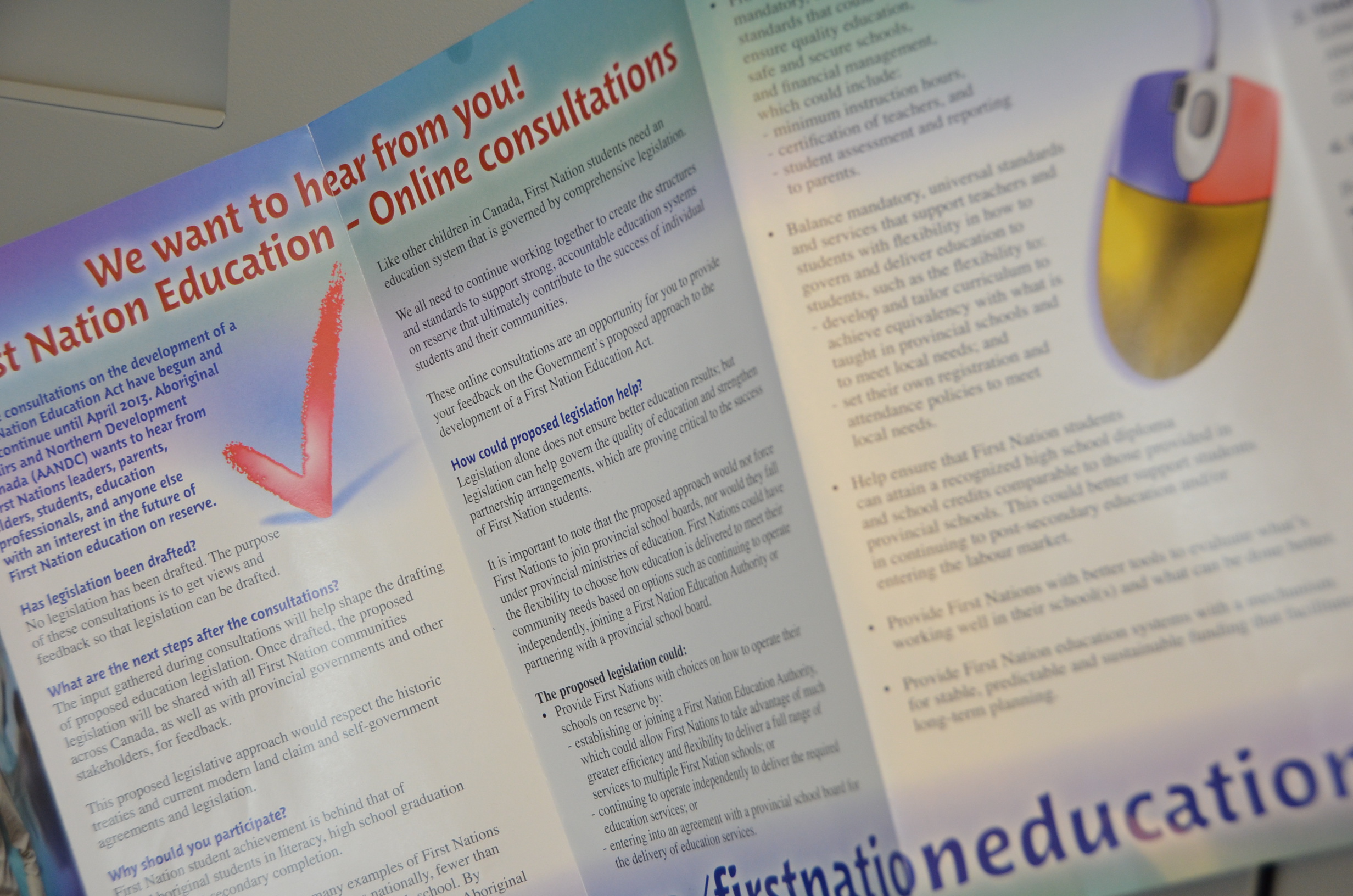
The Toronto Star has run an excellent, but disturbing, series called “Unequal Justice” that cites data on the rate of incarceration among Aboriginal people that should shock us. It’s worth a read. For example, Aboriginal boys make up just 2.9% of the general population, but 15% of admissions into custody. That’s 5 times higher than the rate of other young males. Black youth are incarcerated at a rate of 4 times more than the general population. For white and other ethnic youth there is no such increase. The Star series provides an excellent snapshot of current data to cause one to ask some basic questions about our justice system. It reminds me of the quote from the 60’s: Is it justice or “just us’?
The picture is even more disturbing for Aboriginal girls who have an admission and incarceration rate 10 times higher than other females in the general population. And this trend rises while the rate of crime is declining overall. Think about that for a moment…. We are putting more people in jail even though fewer crimes are being committed. And, those we incarcerate at higher rates tend to be non-whites. Are we supposed to believe that some people are genetically predisposed to committing more crime? Now, that would indeed be wacky science and we’ve been down that road too many times in our human history already. No, genetics is not the reason. The reason is rooted in society being reactive rather than proactive. Instead of allowing conditions to reach crisis proportions before we notice them we should all be engaged in fostering those conditions that support the needs of all people in Canada. Only that will lead to lower incarceration rates overall, and, specifically for populations that are over represented in our justice system.
In adult jails, the rate of incarceration for Aboriginal peoples is 6 times higher and 4 times higher for persons of colour than that of other populations. In reading this your first thought may be, “wow, that’s a lot of victims out there”. There is no victimless crime and no-one should diminish their suffering. But, would there be so many victims if the system wasn’t so broken? Shouldn’t we be looking at how we got here and how to prevent it from here?
I have never received a brochure from the government asking me for my input on why we incarcerate some members of our society more than others. I have never received a brochure asking my opinion on living conditions on reserves. I have never received a brochure seeking my views on treaty rights. I have never been asked about how we treat prisoners in regards to double-bunking, reduced educational opportunities or counselling services while incarcerated. It kind of begs the question then… why I am being asked only about educational opportunities provided to Aboriginal youth?
Sure, good education will help mitigate against one of the major root causes of crime, and I applaud that. But so will good housing, safe water, help for mental health and addictions and so on.
All of which leads me to wonder whether we are asking the right questions. By focusing only on education are we turning the light away from all of the other life issues that work against public safety? Multiple problems need multiple and integrated solutions.
If, for example, we know that it costs us between $90,000 and $230,000 to incarcerate one person, then why are we not talking about diverting at least some of those resources into programs and social development efforts that will keep people from committing crime in the first place?
I am waiting for the brochure to enter my mail box that will not piecemeal the issues but provide me with an honest to goodness comprehensive picture about the root causes that put some populations are at a social disadvantage for which we all pay dearly in reaction, and more importantly how we can go about changing that.
Now, THAT would be a consultation worth having.
Author: Frank Johnson is a regular guest writer for Smart on Crime in Waterloo Region. Frank is a retired principal with the local Catholic school board, a dad, and sometimes runner who possesses an irreverent sense of humour that periodically gets him in trouble. He lives in Waterloo, Ontario.
Frank Johnson’s writing reflects his own opinions and do not necessarily reflect the views or official positions of the Waterloo Region Crime Prevention Council.


 Author: Karl Garner I was a Case Manager at inREACH a focus on employment for the youth. I am currently working at
Author: Karl Garner I was a Case Manager at inREACH a focus on employment for the youth. I am currently working at  A big part of these two years was assisting the youth in opening a Youth Art Studio. This studio gave opportunities for at-risk youth to express themselves through the creative arts. It gave the youth a chance to engage in a new and healthy outlet to express their emotions, as well as cope with current and past adversities. I also assisted these youth in running their very first Art Show at a local gallery. Some sold their art, some made the paper; but more importantly I noticed a huge boost of confidence in each of the youth who took part in this.
A big part of these two years was assisting the youth in opening a Youth Art Studio. This studio gave opportunities for at-risk youth to express themselves through the creative arts. It gave the youth a chance to engage in a new and healthy outlet to express their emotions, as well as cope with current and past adversities. I also assisted these youth in running their very first Art Show at a local gallery. Some sold their art, some made the paper; but more importantly I noticed a huge boost of confidence in each of the youth who took part in this.


 Author: Paul Field
Author: Paul Field Author: Krista McCann
Author: Krista McCann The most important lessons and understandings learned from inREACH will inspire community action toward a future where all young people feel part of a caring community and have the opportunities and the supports they need and deserve. But, any evaluation isn’t even worth the paper it’s printed on if it just sits on a shelf. We need to apply the evaluation findings so that we can affirm what might already work but also make changes where needed.
The most important lessons and understandings learned from inREACH will inspire community action toward a future where all young people feel part of a caring community and have the opportunities and the supports they need and deserve. But, any evaluation isn’t even worth the paper it’s printed on if it just sits on a shelf. We need to apply the evaluation findings so that we can affirm what might already work but also make changes where needed. Some believe that teenagers – particularly those labelled as “trouble” – don’t want to be involved in community activities or mentoring relationships with adults. The evaluation busts that myth by demonstrating very clearly – that if organizations and communities take the right approach – then many adolescents and young adults, will participate in asset building activities like arts and sports. Many will also seek assistance for challenges they face with things like addictions, gang involvement or finding a job or a home, when they have developed a trusting relationship with an adult who meets them ‘where they’re at.’ The evaluation results also clearly demonstrated that when young people got involved in their communities and received help with life challenges, they experienced many positive benefits and changes. Over 95 % of youth agreed their involvement “helped them move in the direction in life they wanted to go.” For example, youth said:
Some believe that teenagers – particularly those labelled as “trouble” – don’t want to be involved in community activities or mentoring relationships with adults. The evaluation busts that myth by demonstrating very clearly – that if organizations and communities take the right approach – then many adolescents and young adults, will participate in asset building activities like arts and sports. Many will also seek assistance for challenges they face with things like addictions, gang involvement or finding a job or a home, when they have developed a trusting relationship with an adult who meets them ‘where they’re at.’ The evaluation results also clearly demonstrated that when young people got involved in their communities and received help with life challenges, they experienced many positive benefits and changes. Over 95 % of youth agreed their involvement “helped them move in the direction in life they wanted to go.” For example, youth said: Sharing our Story describes key elements of the inREACH approach that was so successful. It took
Sharing our Story describes key elements of the inREACH approach that was so successful. It took Continuing the Learning
Continuing the Learning





 Date Sources: Statistics Canada, Uniform Crime Reporting Survey: CANSIM Table 2520051
Date Sources: Statistics Canada, Uniform Crime Reporting Survey: CANSIM Table 2520051